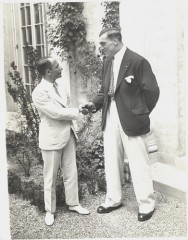
There are a number of greetings that can be used to say hello or goodbye in Italian depending on various factors such as how formal you want to be, what time of day it is, and even when you plan to see someone again.
Hello and Goodbye
The most common, and least formal way to greet someone is ciao, which also has the dual meaning of 'bye'.
Slightly more formally, you can use the word buono/buona meaning 'good', followed by the part of the day you are referring to. Again this can be used both when meeting someone, and when you are parting ways. Buon Giorno is used for 'good morning', Buona Sera can be used as 'good evening' or 'good afternoon' (sera actually means evening, but convention dictates that it can be used any time after someone's had their lunch) and buona notte means 'good night'. In certain circumstances, you could use the word pomeriggio meaning 'afternoon' as in buon pomeriggio; but this is quite formal and mainly reserved for a realm inhabited by news readers.
Buona notte is the equivalent of goodnight, and can only be used when you will not see someone until the next day.
Arrivederci
Arrivederci is used as a more definite, and formal way of saying 'goodbye' and can be broken down into various parts: The initial 'a' meaning 'until', ri- being a prefix meaning 'again' (much like the English re-), veder- is the root of vedere meaning 'to see', and the suffix -ci implies a reflexive pronoun similar to the English 'us'. Hence, arrivederci is something like the Italian equivalent of 'Until we see each other again'. This expression is more commonly employed when the speaker isn't certain when that future meeting will take place.
Addio is the most conclusive form of goodbye and literally translates into 'to God'. This is used when you are certain never to see someone again, or if you're just trying to be dramatic.
Buona Sera VS Buona Serata
To further complicate matters, the suffix -ata can occasionally be added to the end of a word to wish someone a good 'entirety of their day'.
An example of this concept would be that whilst a man might say buona sera to his wife before they go out to separate evening functions with the intention of seeing each other again later that night, he would be more likely to say buona serata to a friend with whom he parts company and does not expect to see again later that same evening.
Other uses
As with any language, there are a number of less formal or colloquial ways to say hello or goodbye. These range from the fairly common phrase a presto which is similar to 'see you soon' through to the rather more unusual 'buon proseguimento' or 'good continuation (of your day...)'. When answering a telephone, rather then saying ciao you would more commonly use the word pronto! or 'ready!'
And when teenagers greet their friends, one colloquial greeting they might use is bella which literally translates to 'beautiful' or, even more bizarrely, the phrase bella zio (zio is Italian for uncle) which is something like the English 'What's up dude/man?'
One last thing you might find useful to remember is that Italians often accompany any greeting with a kiss on each cheek. This applies to people of all ages and even to those of the same sex, so get ready to be a bit more tactile when greeting your Italian friends!